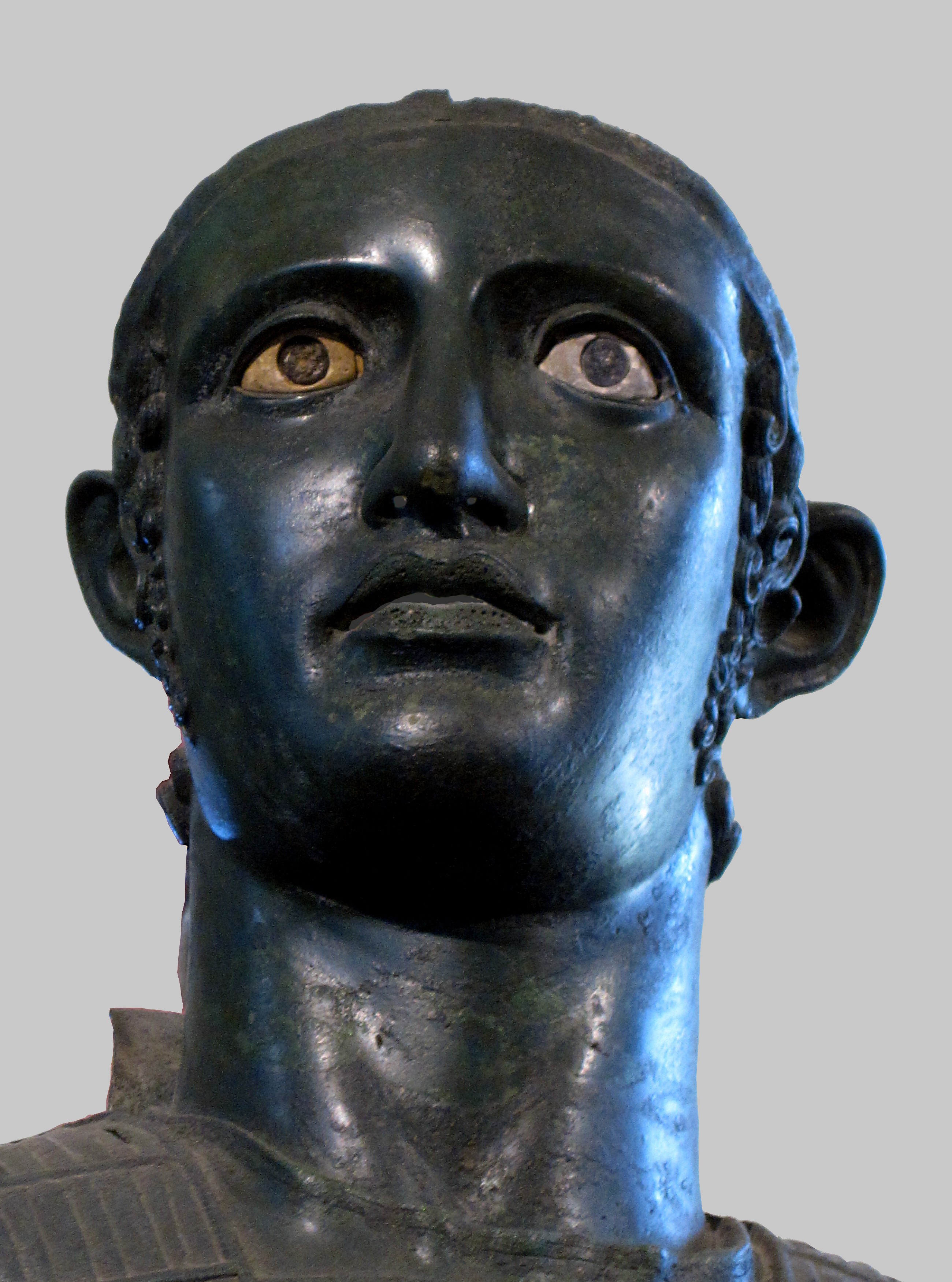Mars of Todi on:
[Wikipedia]
[Google]
[Amazon]
The so-called ''Mars of Todi'' is a near life-sized  The work is a "typical military figure" with "conspicuously Etruscan" facial features. It is an Etruscan realization of Greek formal Classicism, and makes use of the contrapposto posture. The figure probably held a '' patera'' (libation bowl) in his extended right hand, and a spear in the left. His helmet is missing, but his intricate body armor, depicted with "pedantic accuracy," is one of the best examples showing what lamellar plate armor from the period looked like.
The dedication is inscribed on the skirt of the breastplate. It is written in
The work is a "typical military figure" with "conspicuously Etruscan" facial features. It is an Etruscan realization of Greek formal Classicism, and makes use of the contrapposto posture. The figure probably held a '' patera'' (libation bowl) in his extended right hand, and a spear in the left. His helmet is missing, but his intricate body armor, depicted with "pedantic accuracy," is one of the best examples showing what lamellar plate armor from the period looked like.
The dedication is inscribed on the skirt of the breastplate. It is written in
bronze
Bronze is an alloy consisting primarily of copper, commonly with about 12–12.5% tin and often with the addition of other metals (including aluminium, manganese, nickel, or zinc) and sometimes non-metals, such as phosphorus, or metalloids suc ...
warrior, dating from the late 5th or early 4th century BC, produced in Etruria for the Umbria
it, Umbro (man) it, Umbra (woman)
, population_note =
, population_blank1_title =
, population_blank1 =
, demographics_type1 =
, demographics1_footnotes =
, demographics1_title1 =
, demographics1_info1 =
, ...
n market. It was found at Todi
Todi () is a town and ''comune'' (municipality) of the province of Perugia (region of Umbria) in central Italy. It is perched on a tall two-crested hill overlooking the east bank of the river Tiber, commanding distant views in every direction.
I ...
(ancient Tuder), on the slope of Mount Santo.
The bronze warrior was an expensive votive offering made at a religious sanctuary, possibly to Laran
In Etruscan mythology and religion, Laran (or Larun) is the god of war. In art, he was portrayed as a naked youth wearing a helmet, a cuirass and carrying a spear, shield, or lance. Laran also appears to be an underworld god. Among his attri ...
, the Etruscan god of war. It had been buried in antiquity, perhaps ritually, and left undisturbed until its discovery in 1835. It is an example of the highest-quality "prestige" works from Etruria found in Umbria during this period, and probably came from a workshop in Orvieto (Etruscan Velzna, Roman Volsinii). Velzna was known for its bronze sculptures, more than 2,000 of which were looted by the Romans in 265 BC.
 The work is a "typical military figure" with "conspicuously Etruscan" facial features. It is an Etruscan realization of Greek formal Classicism, and makes use of the contrapposto posture. The figure probably held a '' patera'' (libation bowl) in his extended right hand, and a spear in the left. His helmet is missing, but his intricate body armor, depicted with "pedantic accuracy," is one of the best examples showing what lamellar plate armor from the period looked like.
The dedication is inscribed on the skirt of the breastplate. It is written in
The work is a "typical military figure" with "conspicuously Etruscan" facial features. It is an Etruscan realization of Greek formal Classicism, and makes use of the contrapposto posture. The figure probably held a '' patera'' (libation bowl) in his extended right hand, and a spear in the left. His helmet is missing, but his intricate body armor, depicted with "pedantic accuracy," is one of the best examples showing what lamellar plate armor from the period looked like.
The dedication is inscribed on the skirt of the breastplate. It is written in Umbrian
Umbrian is an extinct Italic language formerly spoken by the Umbri in the ancient Italian region of Umbria. Within the Italic languages it is closely related to the Oscan group and is therefore associated with it in the group of Osco-Umbrian ...
in Etruscan characters and marks the beginning of the epigraphic tradition in this part of Umbria. The man dedicating it, however, has a name that is Celtic
Celtic, Celtics or Keltic may refer to:
Language and ethnicity
*pertaining to Celts, a collection of Indo-European peoples in Europe and Anatolia
**Celts (modern)
*Celtic languages
**Proto-Celtic language
*Celtic music
*Celtic nations
Sports Foo ...
in origin, an indication of Tuder's "cosmopolitian" character in the Archaic period. The inscription reads ''Ahal Trutitis dunum dede'', "Ahal Trutitis gave his as agift".
The sculpture is currently held by the Museo Etrusco Gregoriano of the Vatican.
References
{{commons category 5th-century BC sculptures 4th-century BC sculptures 1835 archaeological discoveries Archaeological discoveries in Italy Etruscan sculptures Bronze sculptures